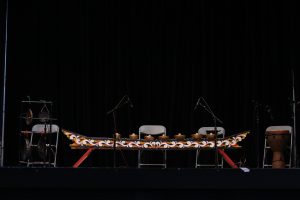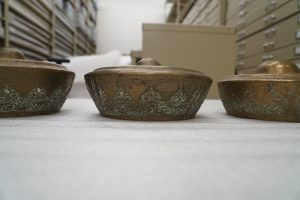Kwintang vs Kulintang
There are many versions of gong sets that vary by region in the southern part of the Philippines but they all come from a strong Muslim influence. Upon first glance at the set in the Burkes collection, I thought it was a kulintang. However, after some research and speaking to a professor who was more versed on the subject, we found out it was a kwintang. We had a guest speaker, Professor Joseph Allen Ruanto-Ramirez from Southwestern College, who told us so much about the different tribes in the southern region of the Philippines and so much backstory on some folk dances that I never knew. They also explained the subtle differences that separate these gongs in both constructions and how they are played.

The kulintang comes from the Maguindanao people in the Mindanao region. Generally, the gongs have detailing on the top surrounding the knob and come in a set of eight organized in a diatonic scale from low on the left to high on the right. They are typically played using an elevated stand (more elevated than the kwintangan) where the gongs are suspended on strings that are tied to the angtangan or kulintang stand with the player sitting in a chair.[1] While it can be played by itself, it’s more commonly played with an ensemble known as a Pala Buni Bunyan. This ensemble consists of the kulintang, agung, dabakan, and more depending on the size of the group.

The kwintang comes from the Yakan people of Basilan. The gongs have detailing around the edge and come in a set of five to six, depending on if the timing gong is included. While they are played using a slightly elevated stand, the player sits on the ground to play it. [2]
Taking the time to learn about the differences between the two was something that became quite important to me because it encapsulates how despite being part of the same region, something so subtle can be the key difference between groups of people.

